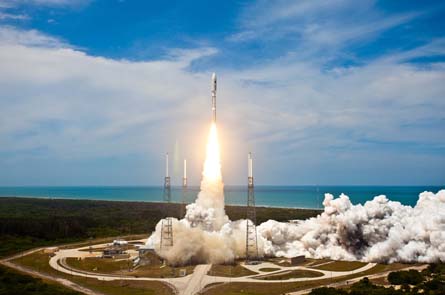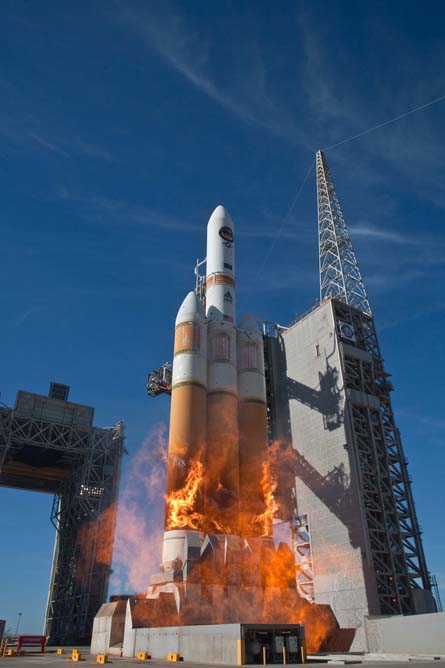For better or worse, the future of US military and strategic spaceflight is tied closely to two rockets: Lockheed Martin's Atlas V and Boeing's Delta IV - both evolved expendable launch vehicles (EELVs) marketed and flown by United Launch Alliance (ULA).
ULA - a 50-50 joint venture between Boeing and Lockheed Martin to serve US government launch customers including the Department of Defense, NASA and the National Reconnaissance Office - has a virtual monopoly over large US government launches, which represent the largest market in the world. Cost has been an issue. In a breach of the Nunn-McCurdy Act, per-unit costs have come in 58% above those initially advertised, triggering reviews. Would-be competitors, notably SpaceX, have used the high costs as an argument for their own, less expensive services.
 |
|---|
United Launch Alliance The modular Atlas V launcher has achieved 100% success since introduction in 2002 |
ULA looks immune to competition for the foreseeable future. Its reliability record has been excellent - Atlas V has a 100% success rate since introduction in 2002 and there has been just one Delta IV failure, in 2004 - and government criteria for new entrants call for a daunting number of successful launches for some categories of payload.
COST OF THRUST
The most expensive components of EELVs are the engines. Pratt & Whitney Rocketdyne supplies all EELV propulsion, with the exception of the RD-180 which powers the Atlas core. This engine is built by NPO Energomash in Russia and imported to the USA by RD Amross, an Energomash/Rocketdyne joint venture. In the short term, ULA and Rocketdyne are testing the RL-10C, a new model RL-10 to launch on both Atlas and Delta.
"That programme is fully funded, and eventually we'll be putting that engine across our entire fleet," says George Sowers, vice-president of advanced programmes at ULA.
But it is still essentially the same engine technology. To that end, the US Air Force is looking for an RL-10 replacement.
"The RL-10s are having a problem," says Bruce Thieman, capability lead at the Air Force Research Laboratory's (AFRL) responsive space access office. "[It is] probably the most reliable engine ever built, but the industrial base that makes it possible is going away. So you've got to move to more modern materials that are used by the commercial industrial base. So you've got to redesign that engine."
AFRL's programme is called "upper-stage engine technologies", and spans a number of concepts. Companies are lining up in expectation of a formal request for information on the issue. Traditional players, including Rocketdyne and Aerojet, are to compete, while less prominent ones (such as Xcor and Orbitec) are also exploring applicable technologies. "They're probably going to make a programme decision in the next year, and then it'll probably be a three-year programme of acquisition to replace that upper stage," says Thieman.
With less urgency, the industry is also looking hard at replacements for the liquid-oxygen/kerosene-fuelled RD-180. AFRL and contractor Aerojet have been running the hydrocarbon boost technology demonstrator, looking at ways to get better thrust-to-weight and efficiency out of a hydrocarbon-based engine using the RD-180's footprint.
COST OF WASTE
Expendable systems are, by definition, wasteful - every launch leaves spent stages either in the sea or in orbit. But reusable concepts have so far failed to deliver on promises of either reduced cost or increased flight rates (see P38).
Thieman says: "If you do expendables, you're not going to reduce the cost - maybe 10% is the best we've been able to do working with launch folks. There are things you can do to get better capability - a better engine - but to actually get it cheaper, you've really got to change the paradigm."
A fully reusable launch vehicle is a holy grail of rocket science. AFRL has taken an incremental view, proposing a reusable booster system called Pathfinder. RBS is a two- or three-stage-to-orbit booster system, with a rocket-powered flyback booster for the first stage, which would return to base and land horizontally.
Making the first stage reusable via a rocket-back manoeuvre - gimballing the nozzles to turn - keeps heat on the airframe low, reducing the need for costly and delicate thermal protection.
"The purpose is to do a concept demonstrator that flies out over the water at supersonic speeds, turns around and comes back, and then we're going to put an augmenter on it to drive it up to about Mach 3.5 to make sure you understand all the technical issues," says Thieman.
"You turn an engine around and fly it backwards, the plume will wrap around the vehicle. Will it burn the vehicle? Does it damage the nozzle on the back end? Does it cause thermal problems on the top or the bottom? Fuel sloshes around in the tank - how do you keep the fuel in the back so it feeds the rocket engine? How do you do this autonomously and interface it with the range, because you've now got a vehicle coming back to Vandenberg [AFB] or [Cape] Canaveral with fuel on board - that makes it a flying bomb."
 |
|---|
United Launch Alliance Delta IV, shown here in Heavy version, was designed with the USAF |
In December 2011, Lockheed Martin, Boeing and Andrews Space won contracts to design their own versions of RBS. A downselect to a single company is expected in late 2012 or early 2013, with the winner contracted to build a small working demonstrator by 2015.
Andrews Space is using SpaceX components, while Boeing is designing from scratch. Lockheed is testing hardware components.
"You've got to have a pretty high flight rate to get the trade study to come out where you want to go to a reusable second stage," says Slater Voorhees, Lockheed's RBS programme manager. "And one of the things we agree with the air force on is that use of an expendable second stage helps you stay in the cost box when you're more on the medium level of flight rate [eight to 12 flights per year]."
What USAF will decide is unknown, but Pathfinder is a prelude to a larger vehicle that could lift 67,000lb conversion into low-Earth orbit at half the EELV's costs.
Source: Flight International



















